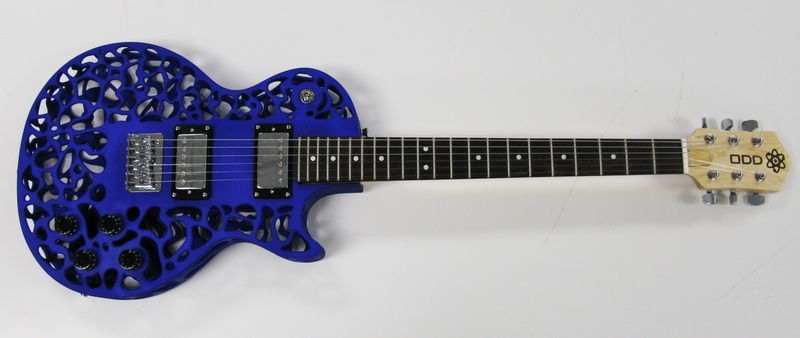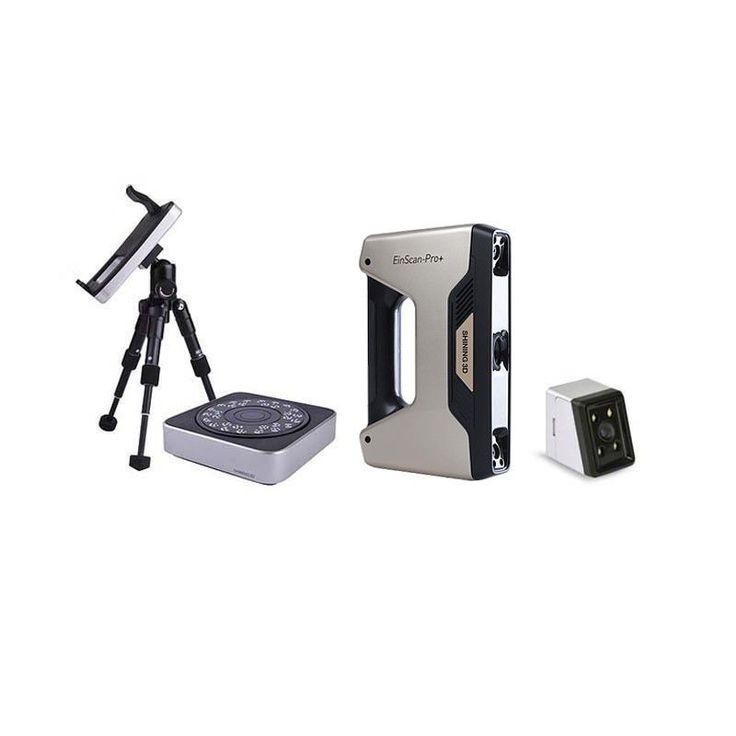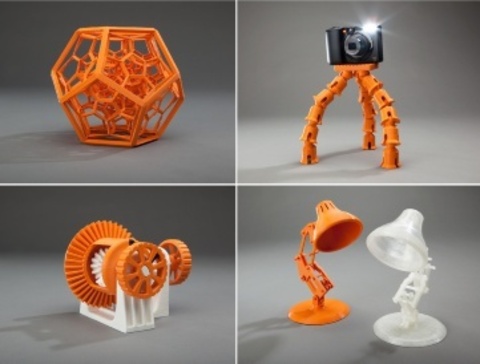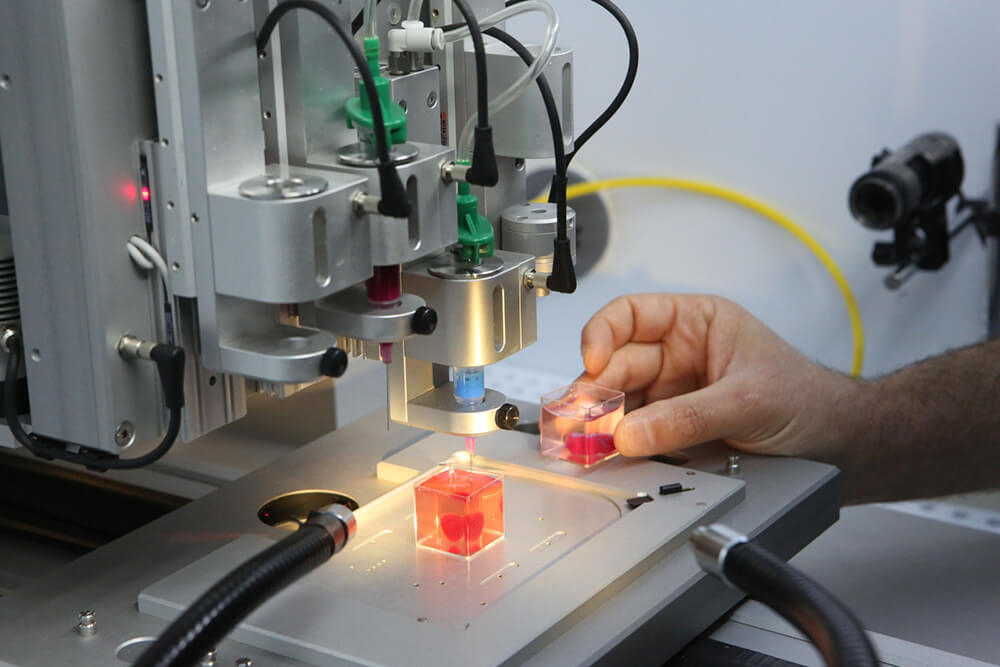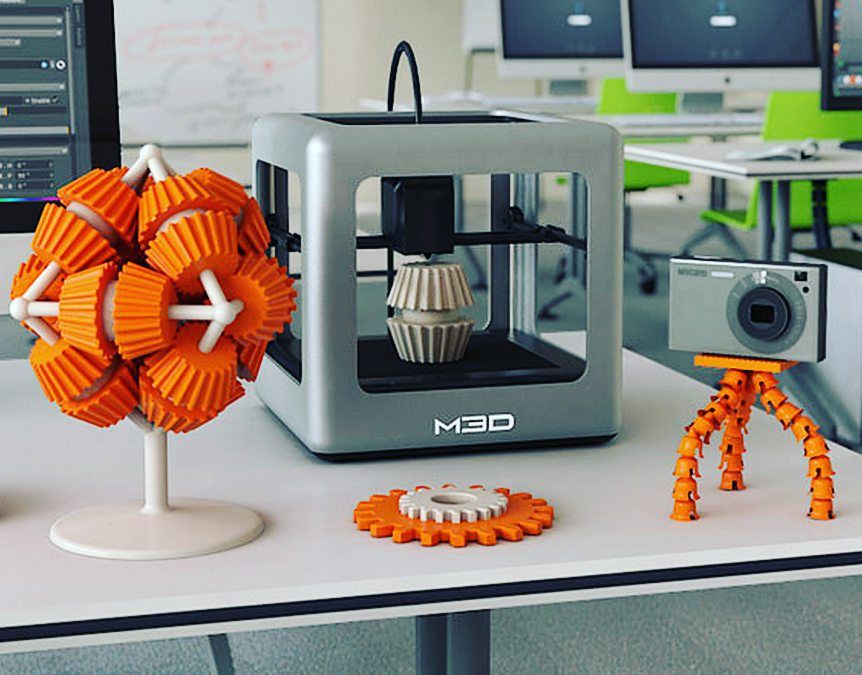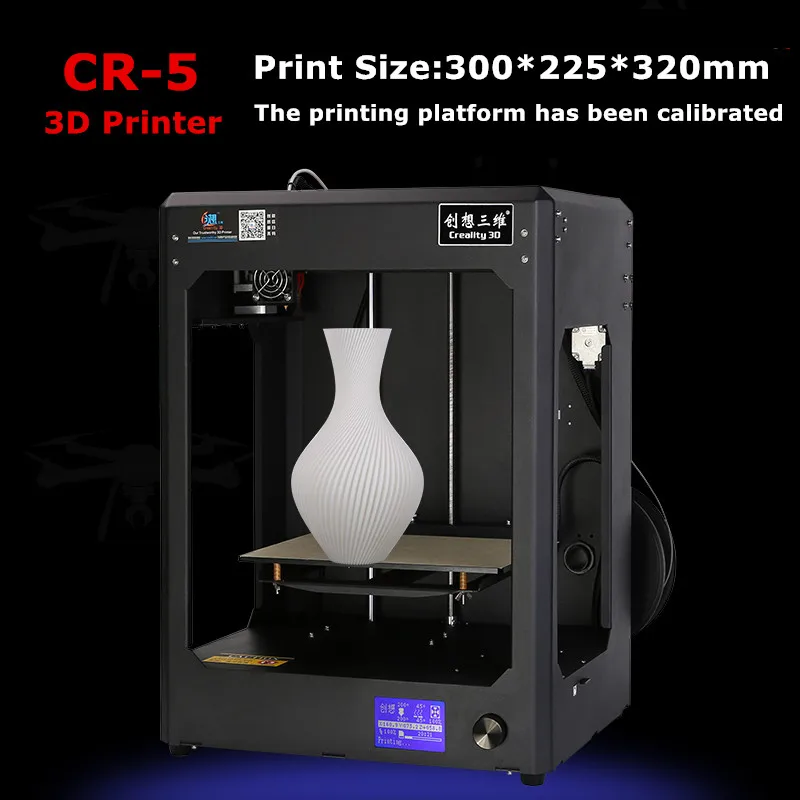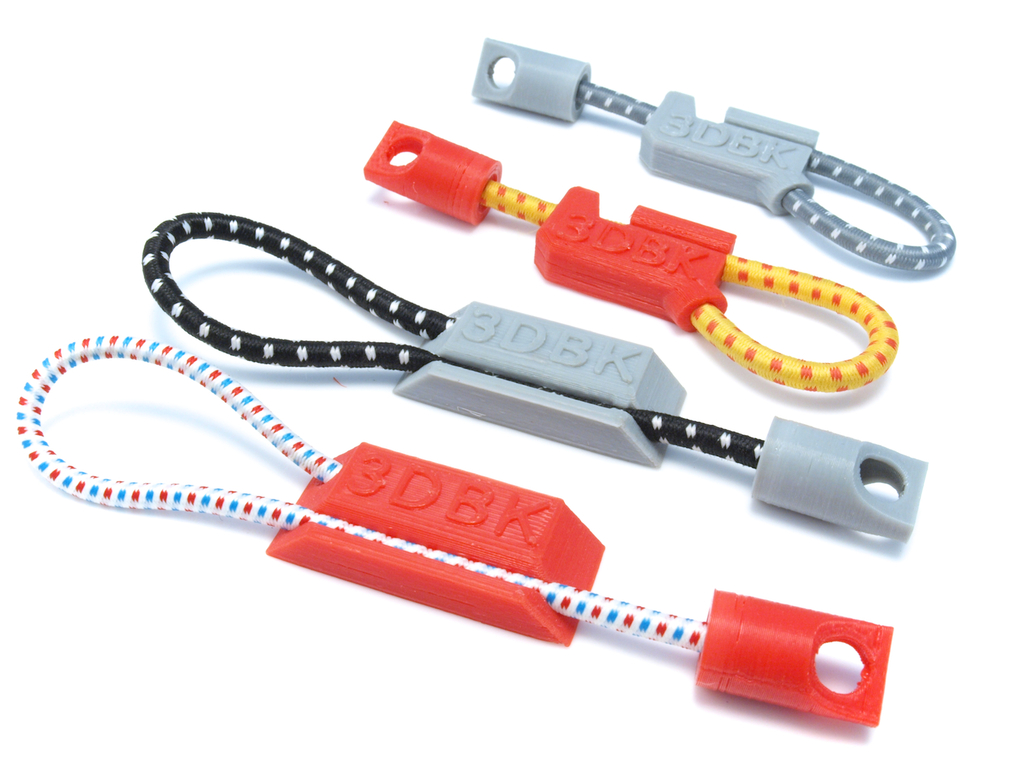3D printer guitar
3D printed guitar accessories - Original Prusa 3D Printers
The ultimate 3d printed accessory for playing guitar is most likely a guitar pick. It’s a super easy and quick print – we have a whole article and video about it. However, it doesn’t end there! You can 3D print many more useful accessories and gadgets – capos, wall mounts, strap locks… Here’s the selection of our favorite models.
Capos
“Oh the song needs a capo, I’m sure I have one… somewhere.” A metal spring-loaded capo costs about $10, the problem is, you never have it on hand when you need it. Somehow, it always ends up in the wrong guitar bag or simply forgotten at home. So it would be really helpful to have a few backup ones.
Download the Ratcheting capo
What does a capo do? Capos are used on fretted string instruments to shorten the string and as a result, raise the pitch. This means that you can play in different keys with the same fingering, rather than having to transpose all the chords to different ones. Changing the key is often used to move the song into your vocal range. Sometimes you can also use it the other way around, to play an easier sequence of chords, while maintaining the original key of the song.
On ukuleles and mandolins, you can get away even with simpler designs. But on the guitar, the force with which the strings need to be held down is quite significant. Without enough pressure, the strings will either be muted or produce an annoying buzzing sound when played. After some searching, we’ve discovered a fantastic design by LoboCNC. It uses a print-in-place hinge and a ratcheting mechanism to clamp down the strings. This makes it very quick to put on and release again. An important feature of a capo, that you’ll often switch its position or remove it completely between songs.
We’ve modified the design slightly (lengthened the ratchet arm) and created a rubber sleeve that can be printed from a flexible filament. It makes it easier to clamp all the strings with enough pressure without having to overtighten the ratcheting mechanism.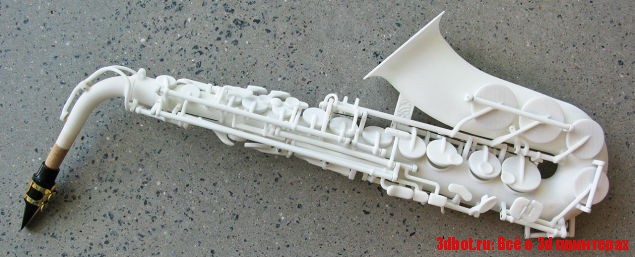 We would also suggest putting some padding on the side that touches the back of your guitar’s neck. The hard plastic could scratch it, which you definitely want to avoid. A couple of pieces of electrical tape stacked on top of each other will do the job nicely. The ratchet was printed from Prusament PETG Prusa Orange.
We would also suggest putting some padding on the side that touches the back of your guitar’s neck. The hard plastic could scratch it, which you definitely want to avoid. A couple of pieces of electrical tape stacked on top of each other will do the job nicely. The ratchet was printed from Prusament PETG Prusa Orange.
Guitar string winder bit
If you’re the kind of person who hasn’t changed the strings on your guitar in years, please, do it for us.😁 Even if you’re not a frequent player, it’s a good idea to change the strings at least once a year, you’ll feel and hear the difference.
If you own a guitar with locking tuners, replacing a guitar string is a breeze. However, on standard tuners, twisting them can get quite tedious. Especially if you’re replacing an entire set of strings. With a printed string winder bit, you can use an electric screwdriver to make the process much faster. For unwinding the string, it’s fantastic. Be extremely careful using it for winding the new string though.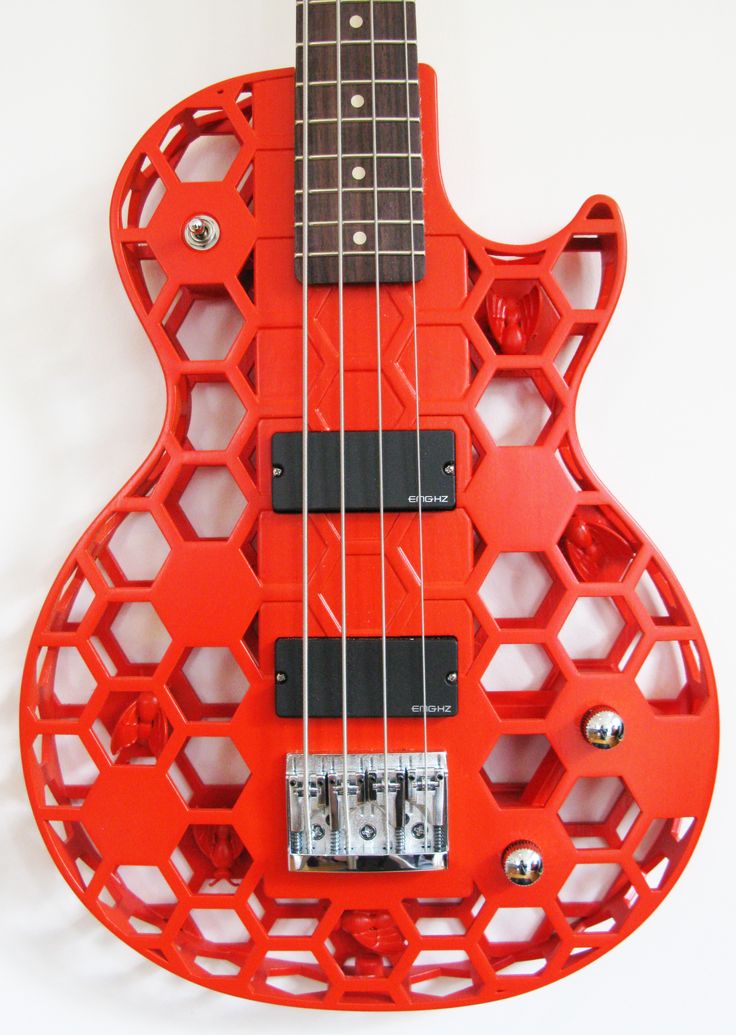 As soon as you feel the string getting any tension whatsoever, it’s time to continue winding it by hand. We tested the guitar string winder drill bit by Keksa and Guitar string winder drill bit by bassklampfe, both worked great.
As soon as you feel the string getting any tension whatsoever, it’s time to continue winding it by hand. We tested the guitar string winder drill bit by Keksa and Guitar string winder drill bit by bassklampfe, both worked great.
Under String radius gauges
Guitar string height (or action) is something that you can adjust on most electric guitars. Typically, you want the strings as low as possible for comfortable fingering. But also high enough so that even at maximum vibration the string won’t hit the metal frets beneath it and start buzzing. The strings should form a nice arc, matching the radius of the guitar’s neck. You do not want a sudden height change between them. This can be fairly difficult to achieve, especially if it’s the first time you’re adjusting it. With these 3D printed under-string radius gauges by Chris, you can simply raise the strings all the way up and then slowly lower them down, until they touch the gauge. Quite handy!
Wall mounts
Even though the primary purpose of a guitar is obviously to be played, it can also work as a nice room decoration. A few guitars hanging on the wall can completely change the vibe of a room. We were initially a bit skeptical whether a 3D printed wall mount will be strong enough to support the weight of a guitar. But we were pleasantly surprised with how sturdy they are. We tried breaking them, pulling on the guitar or hitting the hanger from the top. The only holder we managed to break was the Guitar holder (normal/wide) – wall mount by Mellloun printed from Silk PLA. The additives which make filament shiny also decrease the layer adhesion. Which is exactly the way the holder failed, clean separation along the layer line. Other filaments we tested did not have this problem, including the Prusament PLA Galaxy Black. When printing these, we suggest using at least 4 perimeters, to increase the mount’s strength.
A few guitars hanging on the wall can completely change the vibe of a room. We were initially a bit skeptical whether a 3D printed wall mount will be strong enough to support the weight of a guitar. But we were pleasantly surprised with how sturdy they are. We tried breaking them, pulling on the guitar or hitting the hanger from the top. The only holder we managed to break was the Guitar holder (normal/wide) – wall mount by Mellloun printed from Silk PLA. The additives which make filament shiny also decrease the layer adhesion. Which is exactly the way the holder failed, clean separation along the layer line. Other filaments we tested did not have this problem, including the Prusament PLA Galaxy Black. When printing these, we suggest using at least 4 perimeters, to increase the mount’s strength.
Guitar wall mount by XYZ_Pierre
Guitar holder (normal/wide) – wall mount by Mellloun
Strap lock
This 10-minute print can prevent your guitar from being dropped and getting damaged.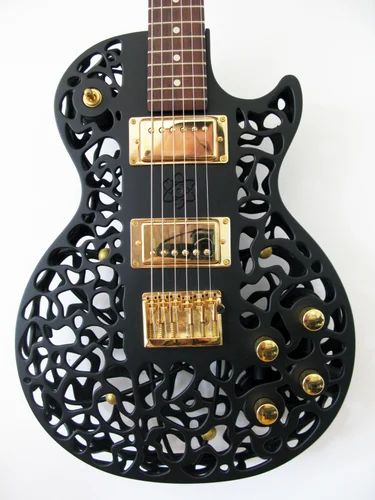 Hopefully, it never happened to you, but some straps have quite a loose fit and catching the guitar just in time after the strap slipped is nerve-wracking. With the strap lock, you don’t have to worry about it anymore. You can print it in black, which will make it almost invisible, match the color of your guitar or choose a nice accent color.
Hopefully, it never happened to you, but some straps have quite a loose fit and catching the guitar just in time after the strap slipped is nerve-wracking. With the strap lock, you don’t have to worry about it anymore. You can print it in black, which will make it almost invisible, match the color of your guitar or choose a nice accent color.
Strap lock on PrusaPrinters.org
Guitar pick holders
One way to mitigate the picks disappearing seemingly into thin air is to print a pick holder. There are tons of designs on PrusaPrinters. The design by Lucas. G a attaches to a mic/guitar stand, it can hold just 3 picks, but they are extremely accessible. The guitar pick holder by Mike VvT is a super simple design, that you can fairly easily re-scale to fit most pick sizes. And the Telecaster guitar pick stand by Ettyl Vrye holds just one pick, but it just looks so funny, it would work great even as a gift for a friend.
What’s next?
In the past, we covered 3D printing and playing on recorders, ocarinas and kazoos.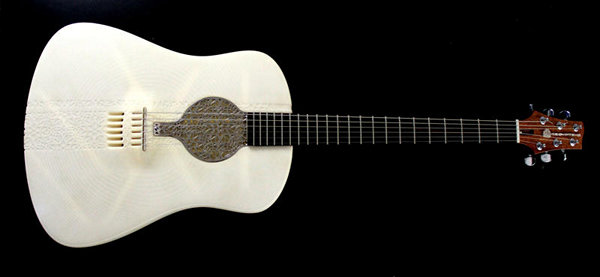 And when talking about playing guitar specifically, we investigated if it’s possible to 3D print guitar picks and how well they perform. But we’re already working on a new project and let’s just say, that this time it’s much bigger than a guitar pick. 😉 Stay tuned for more articles and videos about 3D printed musical instruments and as always – happy printing!
And when talking about playing guitar specifically, we investigated if it’s possible to 3D print guitar picks and how well they perform. But we’re already working on a new project and let’s just say, that this time it’s much bigger than a guitar pick. 😉 Stay tuned for more articles and videos about 3D printed musical instruments and as always – happy printing!
13 of the most amazing 3D-printed guitars
Introduction
If weird guitars are your game, forget mahogany, alder and maple: 3D-printed guitars are the future of ambitious axe design, and they're here to stay.
We've scoured the globe to bring you 13 of the most intricate, awe-inspiring designs; they're not cheap, but in some cases you can download the specs and – providing you have the requisite equipment (we don't, sadly) – you can print them yourselves.
Don't Miss
These awesome movie-inspired electric guitars combine celluloid and nitrocellulose
Elephants, racing cars and more: how to make 13 weird noises with your guitar
The 8 best guitar innovations of 2015
$4,000
ODD Guitars Americana
We could fill this gallery entirely with ODD Guitars man Olaf Diegel's off-the-wall creations, but the Americana is perhaps the most detailed of his efforts.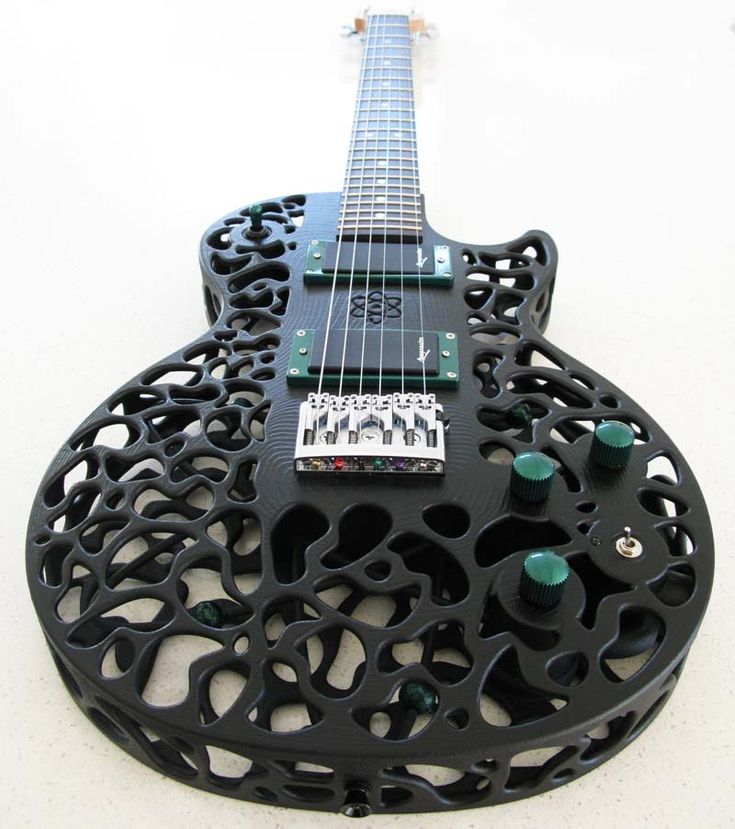
A Duraform nylon-like body is complemented by a wooden inner core (with a choice of wood), which links the Warmoth maple neck to the bridge for customisable sustain and tone.
Most impressive are the replicas of New York landmarks hidden inside the guitar – everything from the Empire State Building to the Statue of Liberty and the Yankee Stadium are crammed into the body. Take a closer look below.
$3,500
ODD Guitars Atom
More ODD Guitar action: the Atom's body is “inspired by the patterns of oil coalescing on water”, while it also features an internal atom with spinning electrons.
Again, Duraform PA provides the bulk of the body, while a wooden inner core adds sustain and tone. Seymour Duncan Jazz SH-2 (neck) and JB SH-4 (bridge) fill the pickup cavities.
£1,500
Customuse RodeoMuse
Shortly after Customuse's inception in 2014, Klaxons began playing their guitars live – a real testament to the quality of these University of Sheffield graduates' designs.
The RodeoMuse rather boldly claims to be “the ultimate country and blues guitar”, with an oak leaf pattern and 3D-printed wagon-wheel volume and tone knobs really hammering the point home.
Buyers do get a choice of centre block tone wood, while a pair of Seymour Duncan Alnico Pro 2 pickups are the finishing touch.
£1,500
Customuse NecroMuse
A fine example of the kind of eye-popping designs 3D printing makes a reality, the NecroMuse is a terrifying creation, boasting an intricate rib cage, rippling spine and grinning skulls, all made out of a durable polymer.
Like other Customuse designs, a wooden centre block retains sustain and resonance, and there's a choice of Seymour Duncan pickups, but best of all, the guitar's output jack is actually one of the skull's eye sockets – ouch.
Francesco Orrù Lovecraft-inspired guitar
This Italian 3D artist living in London has a wealth of incredible 3D-printed designs to his name, and this bonkers example pays homage to the artwork of HP Lovecraft.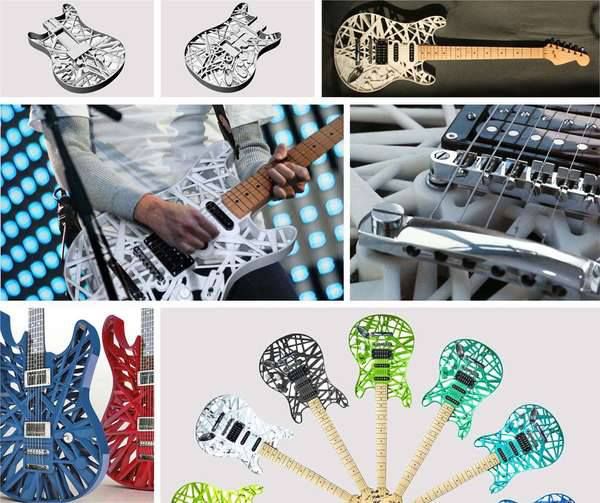
ZBrush software provided the basis for the design element, based on Lovecraft's Godfish and Necronomicon works, then the guitar was 3D printed in eight different parts over 80 hours using a Delta Wasp 3D printer. Phewph.
Animal 4theswarm guitar
Yes, it's Francesco Orrù again, this time with a stunning guitar depicting a lion, eagle and shark.
It doesn't look like this one ever got completed with the requisite neck, pickups and hardware, but you can download the template and print and finish one yourself.
3D Printing Solutions Guitar Project
Designed and printed in four parts on the UP Box 3D Printer, this instrument from Australia's 3D Printing Solutions combines a Telecaster-like look with a cool playing card suite motif.
A maple neck and mahogany body keep traditional guitar credentials in check, but this 3D innovation is so designed that you can change to different 3D printed bodies in under 45 minutes.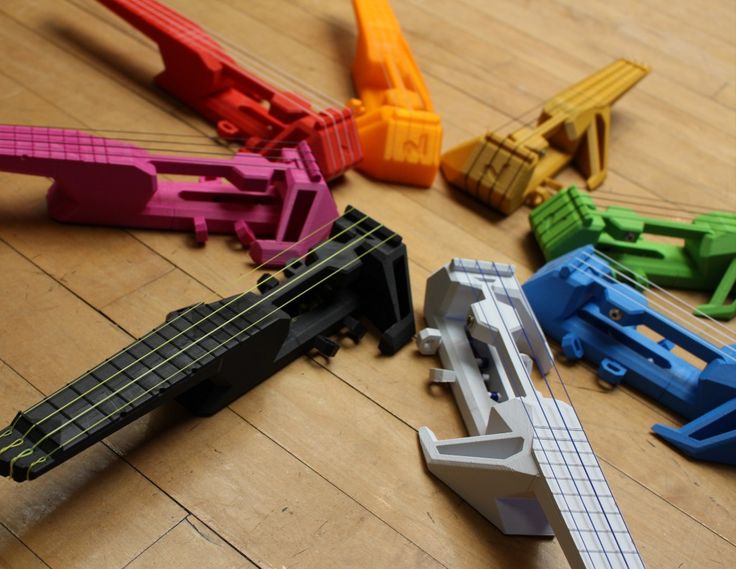
Print one yourself here!
3FM Serious Request guitar
Right, bit of a weird story behind this beauty, which starts thusly: Dutch radio station 3FM Serious Request raises money for charity by locking three of its DJs up for six days a year, forcing them to live on a juice-only diet.
In 2014, Dutch company ASSEMBL3D (see what they did there?) and guitar builder Eugen Wulff bolstered funds by creating a 3D-printed guitar, which made references to the city of Haarlem, the site of that year's DJ lock-up.
The resulting guitar encompassed references to architecture, painters and Serious Request, and impressed a number of famous Dutch artists (so we're told) – watch Arnold van Dongen strut his stuff below.
The whole process took 76 hours, including the classy rust finish, but it was worth it, as the final instrument sold for €5,750, which went to female victims of war and sexual violence.
Scott Summit 3D-printed acoustic
With the help of 3D Systems, 3D artist Scott Summit produced this awe-inspiring matt black strummer.
Printed using a fine nylon powder, Summit's guitar utilised a whopping $3,000 worth of plastics – so, it's certainly not a cheap option for designing your own guitar – but as sceptical as most guitarists are of a non-wood instrument, Summit claims, “It’s rich and full and has a great tonal range.”
Back in 2012, Summit and 3D Systems were looking to advance the production of this one, but we haven't heard anything since.
Widows Web 3D Printed Guitar
Looks like this body had a chance encounter with a meteor shower, but Jessie Sasser's Widows Web design – recently showcased at CES 2016 – certainly encapsulates its title.
Built out of six different pieces printed on a Robo 3D R1 and assembled using LocTite plastic bonder, the Widows Web also features a Fender-style neck and electronics – we like the red strings, too.
Jessie details the build in the video below, and you can download the design from Thingiverse.
$4,000
ODD Guitars Steampunk
While the shape is total Telecaster, the Steampunk's design and execution is pure Wild Wild West: and yes, all those cogs actually move!
Ignoring the incredible airbrushed paint job, the most impressive part of this guitar is that the whole lot – cogs 'n' all – is printed as a single component.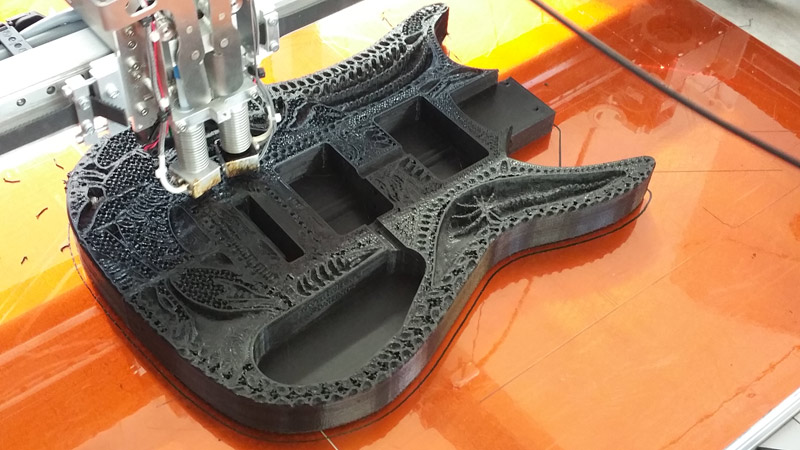
A maple core gives the guitar its tone and sustain, while DiMarzio Area-T and Fast Trick single coils offer a range of T-type tones – it's all printed using selective laser sintering (SLS) by 3D Systems, on an sPro 230 SLS machine out of Duraform (nylon) material.
Jeff Kerr 3D-printed acoustic
There's not a whole lot of info on this one out there, but this acoustic seems to have its own internal LED light, which accentuates the unusual internal bracing, itself used to support the thin exterior.
More impressive still is that not only did The Foundry's Jeff Kerr design and make the guitar, but he designed the printer that printed it, too. The man's some kind of genius – watch him jam on his creation below.
Shapespeare Fully Printed Electric Guitar
Now, while this isn't one of the most remarkable 3D-printed body designs, this, ahem, blue print from Thingiverse user Whitney Potter is notable for being entirely 3D printed – including the neck and fingerboard (but not the hardware, pickups, knobs and strings, natch).
Whitney notes that, “The first one printed plays, although not well, so this should be considered a work in progress and maker beware. I designed this as a 'could it be done' exercise more than anything.”
Carbon fibre reinforcement provides the neck with the stability to cope with the string tension, while the printed fingerboard includes printed slots for fretwire.
Don't hold your breath for an influx of 3D-printed necks in the future, though, as Whitney says, “At this point it is fairly pointless to print the neck as far superior stock guitar necks are available for less than the cost of the materials.”
You can download the design on Thingiverse.
Don't Miss
These awesome movie-inspired electric guitars combine celluloid and nitrocellulose
Elephants, racing cars and more: how to make 13 weird noises with your guitar
The 8 best guitar innovations of 2015
Mike is Editor-in-Chief of GuitarWorld.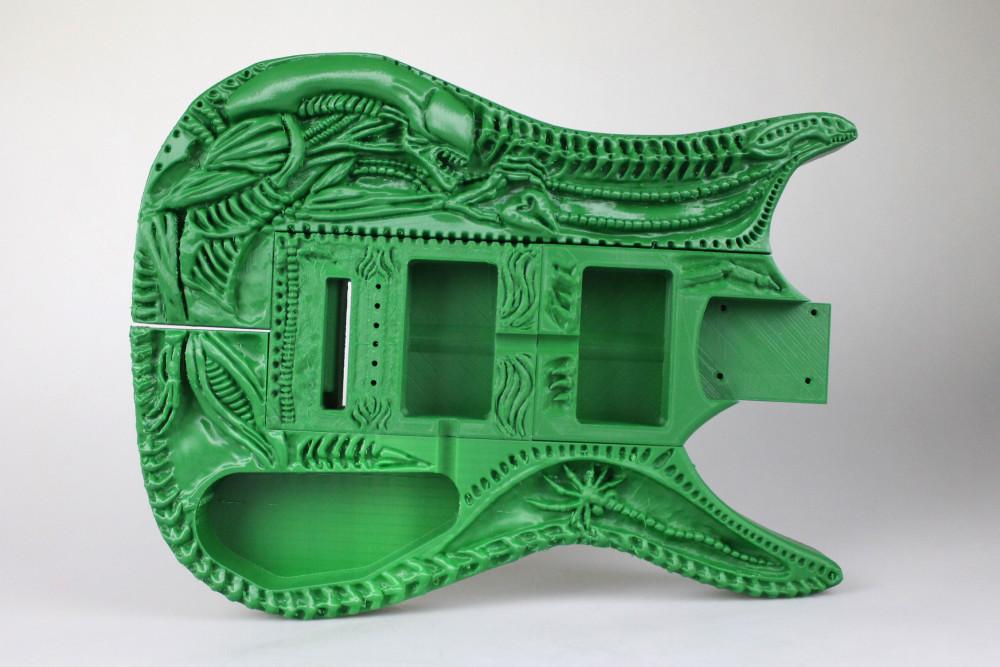 com , in addition to being an offset fiend and recovering pedal addict. He has a master's degree in journalism, and has spent the past decade writing and editing for guitar publications including MusicRadar, Total Guitar and Guitarist, as well as a decade-and-a-half performing in bands of variable genre (and quality). In his free time, you'll find him making progressive instrumental rock under the nom de plume Maebe .
com , in addition to being an offset fiend and recovering pedal addict. He has a master's degree in journalism, and has spent the past decade writing and editing for guitar publications including MusicRadar, Total Guitar and Guitarist, as well as a decade-and-a-half performing in bands of variable genre (and quality). In his free time, you'll find him making progressive instrumental rock under the nom de plume Maebe .
A guitar on a 3D printer or a summer project
Good afternoon, dear readers. Today's article will no longer be an overview, but a creative and practical one, dedicated to hobbies and hobbies.
Introductory lyrics.
In my student years, I happened to play the rhythm guitar in a musical group whose work was in the style of Heavy / Speed Metal (in a simple way - they played ROCK).
Every year, I and probably many of you think that life flies by, accelerating and accelerating, and somewhere far away there are dreams and there is absolutely no time for their fulfillment. But nostalgia and the desire not to give in to despair sometimes help make dreams come true or return to a long-forgotten hobby. This happened to me as well. I managed to escape from the working routine, and pick up the guitar again. Having acquired a tool, I began to restore long-forgotten skills. nine0003
But nostalgia and the desire not to give in to despair sometimes help make dreams come true or return to a long-forgotten hobby. This happened to me as well. I managed to escape from the working routine, and pick up the guitar again. Having acquired a tool, I began to restore long-forgotten skills. nine0003
At one fine moment, the instrument became "not enough" and I wanted to buy something else that sounded different. I considered various options, and at some point the thought came - why not assemble the guitar myself. There is a 3D printer, there are filaments, examples of manufacturing are in plain sight. So the idea of a 3D printed guitar slowly began to flicker, until an interesting project caught my eye:
Why not, I said to myself. Found the description of the project on thingiverse. The body of this instrument was based on the design of guitars from the "state" manufacturer Strandberg guitar. Exactly what is needed! But without backlight - it's superfluous.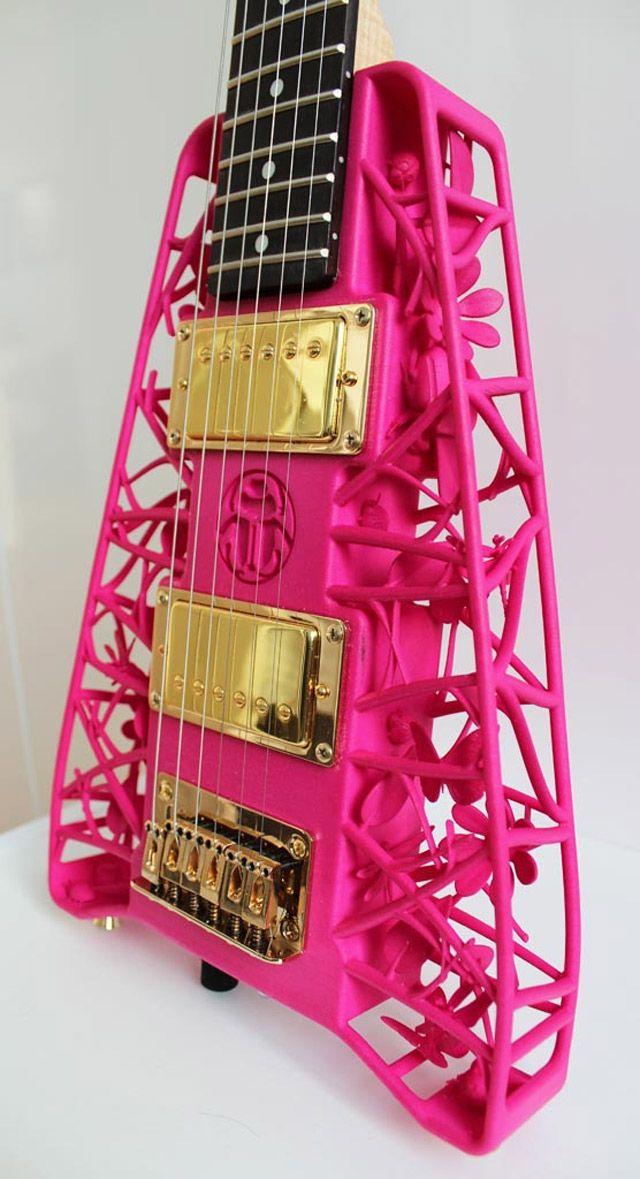 nine0003
nine0003
Preparation
"Wishlist" is not enough to make wishes come true, so a rough list of everything needed for manufacturing was compiled:
3D printer
Picaso Designer Classic. None of them were suitable for the project, because did not have enough printable area for those models that are hosted on Thingiverse. There was no desire to break / saw the finished models, especially the central part of the guitar, to which the neck was to be attached, the pickups were to be placed, and also where the tremolo was installed. This is the most loaded part of the case and should have been printed in its entirety without breakdown. nine0003
As a result, after turning and twisting the models in slicers, it was decided to print on Picaso, because in principle, everything was placed at an angle, except for the central part, and the quality of the printed wall on this machine was quite suitable for my tasks. It was decided to print the central part at a printing studio or ask friends with larger printers.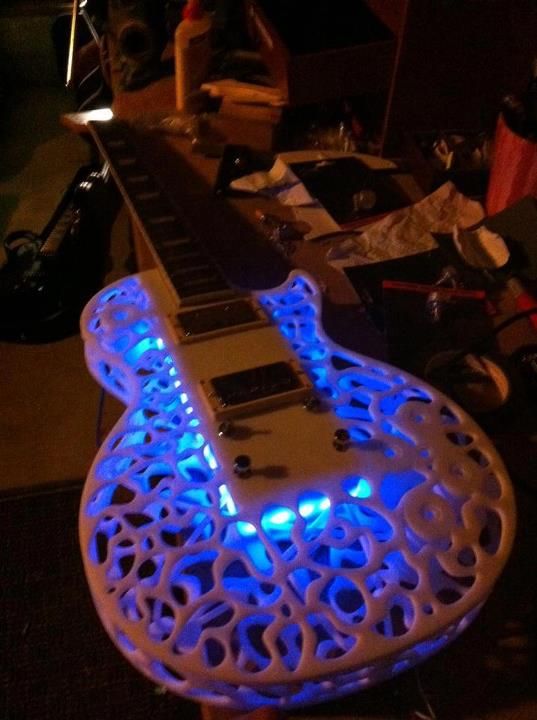
Printable plastic
The author of the project on Thingiverse made a guitar from PLA plastic, but I did not like this option at all, since in this case the guitar would have to be primed and painted. My task was to make a tool without post-processing and painting, so that it could be seen that it was made using 3D printing, but at the same time, it did not have a completely collective-farm look. After looking through the reviews of plastics on 3Dtoday, I decided to focus on composites, especially since I had a shareware promo reel of FormaX composite from REC3D. Once, at one of the 3D printing exhibitions, I happened to turn a part made of this material in my hands, and then I also noticed an interesting visual effect that hides layers and makes the surface of products pleasant to the touch. An additional plus in this solution was the presence of carbon fiber additives in the filament, which should create additional shielding (so that the guitar does not "start" when played). nine0003
nine0003
Donor guitar
Inventing a printed neck is, of course, beyond the bounds, so only the body should be printed, but let's look for the neck, and at the same time all the electronics from the donor guitar will come in handy. There were a lot of options on avito, and in the end, Jackson, who had seen life, was purchased as a donor:
At home, the guitar was immediately dismantled, the neck was washed, polished and put in order. (guitars need to be looked after, of course).
Electronics from the guitar was also included in the project. I really liked the black and white combination of pickups. Yes, and FormaX is also black. The only thing that didn't fit the project from the donor was the tremolo bridge - "that iron thing with twists on the body, to which the strings are attached." nine0003
In a music store I picked up an inexpensive option + they also gave me cheap Olympia strings as a gift:
Test printing and fitting of the model x).
 This thermoblock allows you to work at high temperatures with most materials with a working temperature up to 410°C. We install it according to the instructions from the PICASO 3D website - it takes no more than five minutes, calibrate the printer, refill the plastic, get the instruction from REC3D technical support on FormaX printing and run it for test printing - a piece of the rec company symbol. At the same time, we evaluate the wall of the model. nine0003
This thermoblock allows you to work at high temperatures with most materials with a working temperature up to 410°C. We install it according to the instructions from the PICASO 3D website - it takes no more than five minutes, calibrate the printer, refill the plastic, get the instruction from REC3D technical support on FormaX printing and run it for test printing - a piece of the rec company symbol. At the same time, we evaluate the wall of the model. nine0003
Pleasant enough structure.
Another test - printing a piece of the central part of the guitar to assess the strength with a given infill.
Print settings:
- Nozzle temperature: 280°C.
- Table temperature: 95 °C.
- No airflow
- Table adhesive: PICASO 3D printing adhesive.
- Supports strictly from the table (otherwise the internal communication channels will be flooded)
Nozzle in thermoblock steel: 0.5 mm.
The model shows a defect on the wall.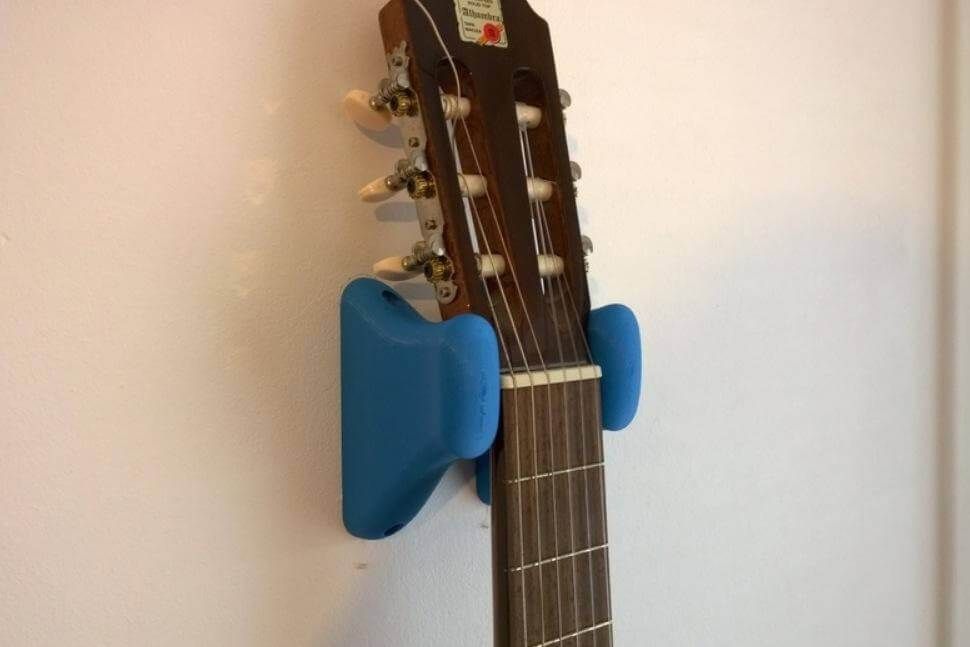 Most likely the reason is in the feed - the material is abrasive and can get stuck in the nozzle. Therefore, we will play with temperatures and retracts during further printing.
Most likely the reason is in the feed - the material is abrasive and can get stuck in the nozzle. Therefore, we will play with temperatures and retracts during further printing.
Also during the test prints with "formax" it became clear that in order to obtain a better surface, it is better to place the part at an angle. In this case, the top, covering layers (which are the front side of the case) will be just as perfect as the side ones. nine0003
Running a little ahead of the story , I show a photo with examples of printing the same part printed at an angle (left) and just on a table (right). The question of further orientation of the model on the table immediately disappeared.
The right part was printed by the PICASO 3D 3D printer farm on the PICASO Designer XL PRO printer at my request. By my mistake in the TOR - the location of the part was flat on the platform and using supports not only from the surface, which led to the fact that the internal cavities for laying communications were filled with plastic, and the surface itself had an unpresentable appearance. I will write about the left part a little later - but I managed to fit it into PICASO Classic and it was printed at an angle. nine0003
I will write about the left part a little later - but I managed to fit it into PICASO Classic and it was printed at an angle. nine0003
As a result of all the trials and tests, it was decided to print all parts at an angle and spend plastic on supports (walk, walk) - I didn’t want to stop the project. To celebrate, another FormaX coil was purchased.
The first high-quality print result met all expectations:
From different angles, plastic plays with both color and texture.
Here are some photos of the rest of the print:
All photos are attached in the original size - you can click the mouse and look closer. The material is absolutely fantastic. After it, I don’t want to look in the direction of PLA and ABS.
Several times I had to stop printing because of problems:
As a result, I got parts for assembling as many as two guitars. In the photo below, parts rejected for various reasons.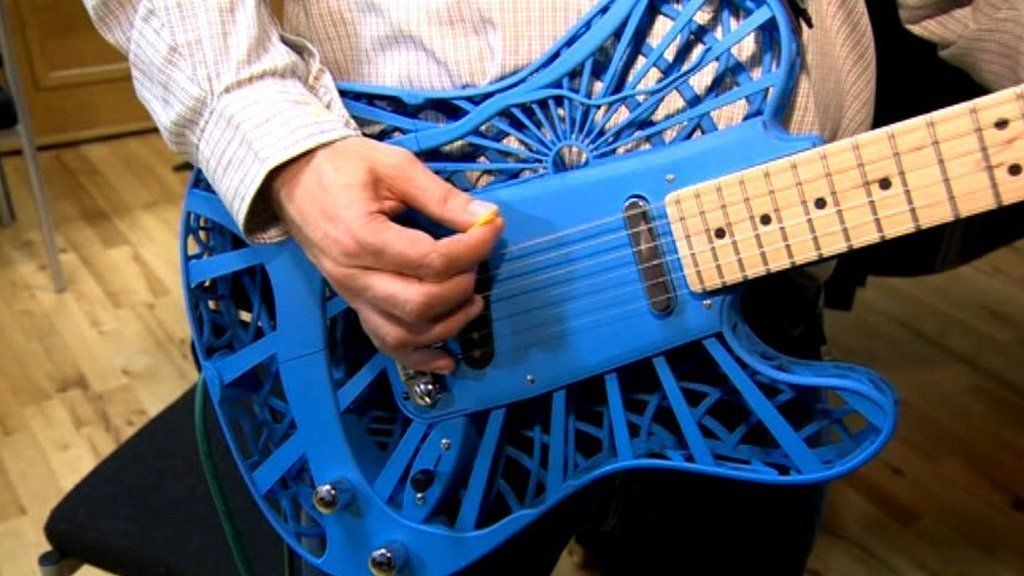
As for the central part of the guitar - I still managed to fit it on the table in the slicer at a certain angle, but when printing, the corner of the model was "eaten", although everything should have fit. nine0003
The problem was found during communication with the representative of PICASO, Kapiton (very competent specialist) . It turned out that with the declared height of the print area, in fact, almost half a centimeter is missing. As it turned out, there was a special revision of the part that protects the coupling under the table screw, and the one that was installed on my printer was larger. They promptly sent me an STL model, I printed it from ABS and replaced it - everything immediately began to fit in height)
Such a stunning surface of parts made from this material. Without post-processing:
While the parts were printed and reprinted, I gutted the donor:
Everything was neatly disassembled, cleaned and set aside for further assembly of the printed version.
During the work, a problem was found in the central part - the neck did not fit into place. He crawled onto the body and covered the part of the pickup with an overlay:
I did not want to cut the neck and it was decided to increase the size of the platform on which it is attached. Since I'm not good at editing STL, I asked Ivan (Plastmaska) for help.
Thanks to Ivan, the printing of the third version of the central part of the body was launched on the same day and the next I had the opportunity to join the parts and evaluate what happened:
Next, the parts were fastened together with using 7 screws M3x10 and 2 screws M3x20 and followed by the assembly of electronics, wiring, installation of the tremolo bridge and neck:
Here I ran into the problem that the power of my "children's" soldering iron for soldering electronics is not enough. I had to call out in 3D chats and Ivan Kashirin (known to many printers in St. Petersburg) came to the rescue. The guitar was carefully transported to Vanya's office and all the electronics were carefully soldered:
Petersburg) came to the rescue. The guitar was carefully transported to Vanya's office and all the electronics were carefully soldered:
After assembly and soldering, it remained to put the strings, set their height, adjust the scale and install printed covers that cover the technological connectors on the back of the case. nine0003
Tuning and maintenance of the guitar was handled by Mikhail Marchenko, a professional in his field. I highly recommend those. who needs to put the instrument in order - https://vk.com/marchenko_mikhail.
A few photos:
Surely many people have a question - why did the project take the whole summer. In general, everything could be done slowly in 3-4 days, but summer is vacations, summer cottages, a lot of work for yourself and that guy, and there wasn’t much time to get down to business. nine0003
Well, a quick video. Happy listening everyone.
Guitar on 3D printer
Composite materials of the X-line range are used not only in the production of mechanical parts and molding equipment, but also in music.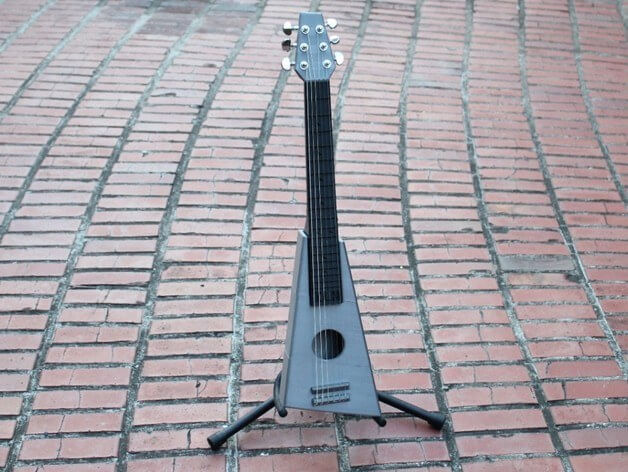 In this example, we'll talk about a FormaX printed carbon-fibre body electric guitar.
In this example, we'll talk about a FormaX printed carbon-fibre body electric guitar.
This project was made by Sergey Pushkin, a St. Petersburg-based maker and founder of the 3Dtoday portal about additive technologies, who has been fond of playing the guitar since a young age. Any musician wants to try new instruments from time to time, and with a 3D printer, a guitar can be made in the original performance. nine0003
Sergey Pushkin, maker and founder of the portal 3Dtoday.ru
The printed guitar in general terms repeats the project of the Spanish maker Julen Echaniz, posted in the public domain on the Thingiverse site. The body of the guitar is based on the characteristic shape of the Strandberg instruments, but with an integrated mosaic pattern of hollow hexagons.
The donor for the new instrument was a Jackson King V guitar purchased on the secondary market. From the old instrument, the pickups and neck along with the pegs migrated to the new one, and the string holder was purchased separately.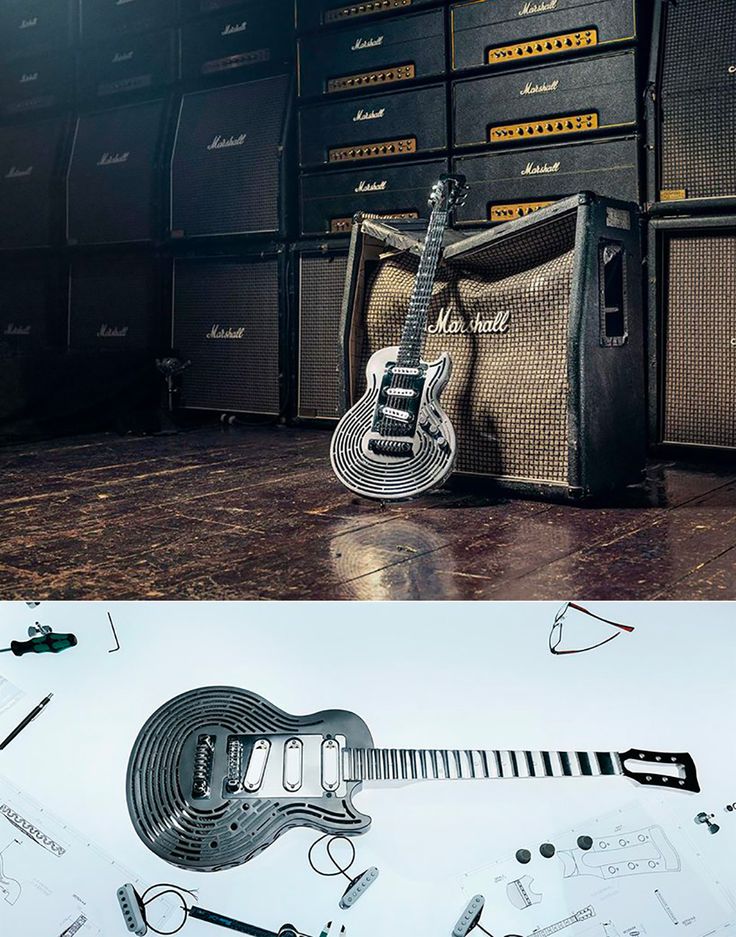 The idea of printing the neck had to be abandoned immediately, since it would be impossible to provide the necessary strength and rigidity on an FDM printer even when using composites. On the other hand, nothing prevents printing an interesting corpus. nine0003
The idea of printing the neck had to be abandoned immediately, since it would be impossible to provide the necessary strength and rigidity on an FDM printer even when using composites. On the other hand, nothing prevents printing an interesting corpus. nine0003
The choice of material was initially driven by the desire to achieve an attractive appearance with a minimum of post-processing and without painting, as well as a stronger construction than common polymers such as PLA or ABS. These requirements were met by carbon-filled ABS plastic FormaX, which is part of the X-line branded composite materials.
FormaX products have an interesting visual effect that hides the layers. The rough surface is pleasant to the touch and shimmers in the light, and an additional plus was the presence of carbon fiber additives that provide additional shielding. nine0003
I had a choice of three devices: Ultimaker 2, Creality CR-200B and PICASO Designer Classic. The problem with all three was that due to usable volume limitations, none of them would be able to print the whole case.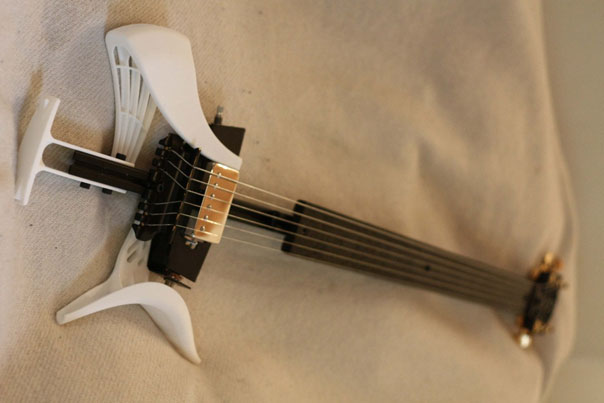 The body had to be broken apart, but the central element - the largest and carrying the main part of the load - was still printed at an angle.
The body had to be broken apart, but the central element - the largest and carrying the main part of the load - was still printed at an angle.
The skew print option proved to be even better than the horizontal part, as it allowed for a higher surface quality, albeit at the cost of high support material consumption. At the same time, the inclined arrangement made it possible to avoid filling the internal communication cavities with plastic. The illustrations clearly show an unusual texture obtained immediately, without any processing. nine0003
All printed parts are made on a PICASO Designer Classic 3D printer equipped with an optional high-temperature fuser with an operating temperature of up to 400°C. Printing was carried out at a temperature of 280°C with heating of the table up to 95°C. A separate point is the use of a steel nozzle, which is more resistant to wear than brass, since carbon fiber additives significantly increase the abrasiveness of FormaX.